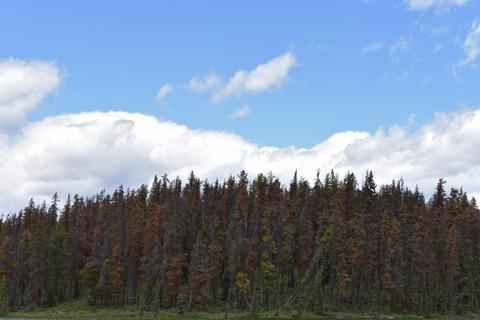当前位置:
X-MOL 学术
›
J. Appl. Ecol.
›
论文详情
Our official English website, www.x-mol.net, welcomes your
feedback! (Note: you will need to create a separate account there.)
Changes in soil fungal communities following anthropogenic disturbance are linked to decreased lodgepole pine seedling performance
Journal of Applied Ecology ( IF 5.0 ) Pub Date : 2020-04-30 , DOI: 10.1111/1365-2664.13628 Jackson L. Beck 1 , Jonathan A. Cale 1 , Jean C. Rodriguez‐Ramos 1 , Sanat S. Kanekar 1 , Justine Karst 1 , James F. Cahill 2 , Suzanne W. Simard 3 , Nadir Erbilgin 1
中文翻译:

人为干扰后土壤真菌群落的变化与黑毛松幼苗性能下降有关
更新日期:2020-04-30
Journal of Applied Ecology ( IF 5.0 ) Pub Date : 2020-04-30 , DOI: 10.1111/1365-2664.13628 Jackson L. Beck 1 , Jonathan A. Cale 1 , Jean C. Rodriguez‐Ramos 1 , Sanat S. Kanekar 1 , Justine Karst 1 , James F. Cahill 2 , Suzanne W. Simard 3 , Nadir Erbilgin 1
Affiliation

|
- Disturbances are frequent events across the Canadian boreal forest and can affect both below‐ and above‐ground ecosystem processes. How disturbances change below‐ground soil fungal communities and in‐turn affect pine establishment and performance is poorly understood. Such understanding has become increasingly important in light of observed changes in disturbance regimes in recent years due to climate change.
- We used a greenhouse experiment to determine how soil inoculum collected from lodgepole pine stands undisturbed (control) or disturbed by fire, mountain pine beetle outbreak, logging and salvage logging affect pine seedling performance in western Canada. We first characterized whether fungal communities of seedling roots change as a function of inoculum source, and then determined whether changes in fungal community composition impact pine seedling performance (biomass and height).
- Root fungal communities of pine seedlings from logged and salvage logged disturbances differed from their respective paired controls, while soils from natural disturbances (fire and beetle outbreak) did not. Among disturbances, the pine root fungal communities of fire and salvage logged disturbances differed.
- In parallel to the root fungal communities, seedling performance also decreased when comparing logging and salvage logging disturbances to paired controls. Among disturbance treatments, seedlings from the salvage logged disturbance did not grow as big as seedlings inoculated with soils from burned forests.
- Synthesis and application. Our findings indicate that anthropogenic disturbances (logging and salvage logging) can have cross‐generational impacts on pine seedling performance, through functional shifts in seedling root fungal community structure. Furthermore, the impacts of soil fungi on pine seedlings appear to be pronounced following salvage logging, stressing the importance of compound disturbance events. These findings may be important to land managers considering clear‐cut logging or salvage logging in pine forests, particularly where soil biotic communities are likely to be one of the predominate factors in pine establishment.
中文翻译:

人为干扰后土壤真菌群落的变化与黑毛松幼苗性能下降有关
- 干扰是整个加拿大北方森林的频发事件,可能会影响地下和地下生态系统过程。人们对扰动如何改变地下土壤真菌群落并反过来影响松树的形成和生长性能的了解甚少。鉴于近年来观察到的由于气候变化引起的干扰制度的变化,这种理解变得越来越重要。
- 我们使用了一个温室实验来确定从加拿大原住民的原木茎上收集的土壤接种物如何不受干扰(受控制)或受火,山松甲虫暴发,伐木和打捞伐木的干扰如何影响加拿大西部的松树苗性能。我们首先表征了苗根的真菌群落是否随接种源的变化而变化,然后确定真菌群落组成的变化是否影响松树幼苗的性能(生物量和高度)。
- 来自伐木和打捞伐木干扰的松树幼苗的根真菌群落不同于它们各自配对的对照,而自然干扰(火和甲虫暴发)的土壤则没有。在干扰中,火和打捞的松树根真菌群落有所不同。
- 将伐木和打捞伐木干扰与配对对照进行比较时,与根真菌群落平行的幼苗性能也下降。在干扰处理中,来自打捞记录的干扰的幼苗的生长不如被烧毁森林土壤接种的幼苗大。
- 综合与应用。我们的发现表明,人为干扰(伐木和打捞伐木)可以通过幼苗根部真菌群落结构的功能转移,对松树幼苗的性能产生跨代影响。此外,打捞后土壤真菌对松树幼苗的影响似乎很明显,强调了复合干扰事件的重要性。这些发现对于考虑在松树林中进行明确伐木或打捞伐木的土地管理者可能很重要,尤其是在土壤生物群落可能是松树建立的主要因素之一的地方。









































 京公网安备 11010802027423号
京公网安备 11010802027423号